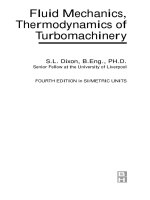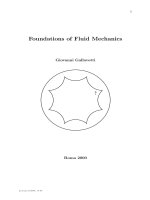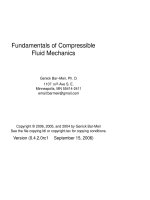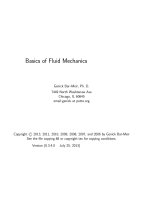Fundamental of fluid mechanics
Bạn đang xem bản rút gọn của tài liệu. Xem và tải ngay bản đầy đủ của tài liệu tại đây (6.14 MB, 90 trang )
Fundamentals of Fluid Mechanics
SUB: Fundamentals of Fluid Mechanics
Subject Code:BME 307
5th Semester,BTech
Prepared by
Aurovinda Mohanty
Asst. Prof. Mechanical Engg. Dept
VSSUT Burla
1
Fundamentals of Fluid Mechanics
Disclaimer
This document does not claim any originality and cannot be used as a substitute for
prescribed textbooks. The information presented here is merely a collection by the committee
members for their respective teaching assignments. Various sources as mentioned at the
reference of the document as well as freely available material from internet were consulted
for preparing this document. The ownership of the information lies with the respective
authors or institutions. Further, this document is not intended to be used for commercial
purpose and the committee members are not accountable for any issues, legal or otherwise,
arising out of use of this document. The committee members make no representations or
warranties with respect to the accuracy or completeness of the contents of this document and
specifically disclaim any implied warranties of merchantability or fitness for a particular
purpose.
2
Fundamentals of Fluid Mechanics
SCOPE OF FLUID MECHANICS
Knowledge and understanding of the basic principles and concepts of fluid mechanics are
essential to analyze any system in which a fluid is the working medium. The design of almost
all means transportation requires application of fluid Mechanics. Air craft for subsonic and
supersonic flight, ground effect machines, hovercraft, vertical takeoff and landing requiring
minimum runway length, surface ships, submarines and automobiles requires the knowledge
of fluid mechanics. In recent years automobile industries have given more importance to
aerodynamic design. The collapse of the Tacoma Narrows Bridge in 1940 is evidence of the
possible consequences of neglecting the basic principles fluid mechanics.
The design of all types of fluid machinery including pumps, fans, blowers,
compressors and turbines clearly require knowledge of basic principles fluid mechanics.
Other applications include design of lubricating systems, heating and ventilating of private
homes, large office buildings, shopping malls and design of pipeline systems.
The list of applications of principles of fluid mechanics may include many more. The
main point is that the fluid mechanics subject is not studied for pure academic interest but
requires considerable academic interest.
3
Fundamentals of Fluid Mechanics
CHAPTER -1
Definition of a fluid:Fluid mechanics deals with the behaviour of fluids at rest and in motion. It is logical to begin
with a definition of fluid. Fluid is a substance that deforms continuously under the application
of shear (tangential) stress no matter how small the stress may be. Alternatively, we may
define a fluid as a substance that cannot sustain a shear stress when at rest.
A solid deforms when a shear stress is applied , but its deformation doesn’t continue to
increase with time.
Fig 1.1(a) shows and 1.1(b) shows the deformation the deformation of solid and fluid under
the action of constant shear force. The deformation in case of solid doesn’t increase with
time i.e t1 t 2 ....... tn .
From solid mechanics we know that the deformation is directly proportional to applied shear
stress ( τ = F/A ),provided the elastic limit of the material is not exceeded.
To repeat the experiment with a fluid between the plates , lets us use a dye marker to outline
a fluid element. When the shear force ‘F’ , is applied to the upper plate , the deformation of
the fluid element continues to increase as long as the force is applied , i.e t 2 t1 .
Fluid as a continuum :Fluids are composed of molecules. However, in most engineering applications we are
interested in average or macroscopic effect of many molecules. It is the macroscopic effect
that we ordinarily perceive and measure. We thus treat a fluid as infinitely divisible substance
, i.e continuum and do not concern ourselves with the behaviour of individual molecules.
The concept of continuum is the basis of classical fluid mechanics .The continuum
assumption is valid under normal conditions .However it breaks down whenever the mean
free path of the molecules becomes the same order of magnitude as the smallest significant
characteristic dimension of the problem .In the problems such as rarefied gas flow (as
4
Fundamentals of Fluid Mechanics
encountered in flights into the upper reaches of the atmosphere ) , we must abandon the
concept of a continuum in favour of microscopic and statistical point of view.
As a consequence of the continuum assumption, each fluid property is assumed to have a
definite value at every point in the space .Thus fluid properties such as density , temperature ,
velocity and so on are considered to be continuous functions of position and time .
Consider a region of fluid as shown in fig 1.5. We are interested in determining the density at
the point ‘c’, whose coordinates are
by ρ=
,
and
. Thus the mean density V would be given
. In general, this will not be the value of the density at point ‘c’ . To determine the
density at point ‘c’, we must select a small volume ,
the ratio
, surrounding point ‘c’ and determine
and allowing the volume to shrink continuously in size.
Assuming that volume
is initially relatively larger (but still small compared with volume ,
V) a typical plot might appear as shown in fig 1.5 (b) . When
becomes so small that it
contains only a small number of molecules , it becomes impossible to fix a definite value for
; the value will vary erratically as molecules cross into and out of the volume. Thus there
is a lower limiting value of
ρ=
5
, designated
ꞌ
ꞌ . The density at a point is thus defined as
Fundamentals of Fluid Mechanics
Since point ‘c’ was arbitrary , the density at any other point in the fluid could be determined
in a like manner. If density determinations were made simultaneously at an infinite number of
points in the fluid , we would obtain an expression for the density distribution as function of
the space co-ordinates , ρ = ρ(x,y,z,) , at the given instant.
Clearly , the density at a point may vary with time as a result of work done on or by the fluid
and /or heat transfer to or from the fluid. Thus , the complete representation(the field
representation) is given by :ρ = ρ(x,y,z,t)
Velocity field:
In a manner similar to the density , the velocity field ; assuming fluid to be a continuum , can
be expressed as : =
(x,y,z,t)
The velocity vector can be written in terms of its three scalar components , i.e
=u +v +w
In general ; u = u(x,y,z,t) , v=v(x,y,z,t) and w=w(x,y,z,t)
If properties at any point in the flow field do not change with time , the flow is termed as
steady. Mathematically , the definition of steady flow is
=0 ; where η represents any fluid
property.
Thus for steady flow is
=0 or
=
= 0 or ρ = ρ(x,y,z)
(x,y,z)
Thus in steady flow ,any property may vary from point to point in the field , but all properties
, but all properties remain constant with time at every point.
One, two and three dimensional flows :
A flow is classified as one two or three dimensional based on the number of space
coordinates required to specify the velocity field. Although most flow fields are inherently
three dimensional, analysis based on fewer dimensions are meaningful.
Consider for example the steady flow through a long pipe of constant cross section
(refer Fig1.6a). Far from the entrance of the pipe the velocity distribution for a laminar flow
can be described as:
=
. The velocity field is a function of r only. It is
independent of r and .Thus the flow is one dimensional.
6
Fundamentals of Fluid Mechanics
Fig1.6a and Fig1.6b
An example of a two-dimensional flow is illustrated in Fig1.6b.The velocity distribution is
depicted for a flow between two diverging straight walls that are infinitely large in z
direction. Since the channel is considered to be infinitely large in z the direction, the velocity
will be identical in all planes perpendicular to z axis. Thus the velocity field will be only
function of x and y and the flow can be classified as two dimensional.
Fig 1.7
For the purpose of analysis often it is convenient
to introduce the notion of uniform flow at a given
cross-section. Under this situation the two
dimensional flow of Fig 1.6 b is modelled as one
dimensional flow as shown in Fig1.7, i.e. velocity
field is a function of x only. However,
convenience alone does not justify the assumption such as a uniform flow assumption at a
cross section, unless the results of acceptable accuracy are obtained.
Stress Field:
Surface and body forces are encountered in the study of continuum fluid mechanics. Surface
forces act on the boundaries of a medium through direct contact. Forces developed without
physical contact and distributed over the volume of the fluid, are termed as body forces .
Gravitational and electromagnetic forces are examples of body forces .
Consider an area
.Consider a force
, that passes through ‘c’
acting on an area
point ‘c’ .The normal stress
are then defined as :
7
=
through
and shear stress
Fundamentals of Fluid Mechanics
;Subscript ‘n’ on the stress is included as a reminder that the stresses are
=
associated with the surface
, through ‘c’ , having an outward normal in
direction .For
any other surface through ‘c’ the values of stresses will be different .
Consider a rectangular co-ordinate system , where stresses act on planes whose normal are in
x,y and z directions.
Fig 1.9
Fig 1.9 shows the forces components acting on the area
.
The stress components are defined as ;
=
=
=
A double subscript notation is used to label the stresses. The first subscript indicates the plane
on which the stress acts and the second subscript represents the direction in which the stress
acts, i.e
represents a stress that acts on x- plane (i.e the normal to the plane is in x
direction ) and acts in ‘y’ direction .
Consideration of area element
. Use of an area element
8
would lead to the definition of the stresses ,
would similarly lead to the definition
,
,
and
and
.
Fundamentals of Fluid Mechanics
An infinite number of planes can be passed through point ‘c’ , resulting in an infinite number
of stresses associated with planes through that point. Fortunately , the state of stress at a point
can be completely described by specifying the stresses acting on three mutually perpendicular
planes through the point.
Thus , the stress at a point is specified by nine components and given by :
=
Fig 1.10
Viscosity:
In the absence of a shear stress , there will be no deformation. Fluids may be broadly
classified according to the relation between applied shear stress and rate of deformation.
Consider the behaviour of a fluid element between the two infinite plates shown in fig 1.11 .
The upper plate moves at constant velocity , u , under the influence of a constant applied
force ,
.
The shear stress ,
=
, applied to the fluid element is given by :
=
Where ,
is the area of contact of a fluid element with the plate. During the interval t ,
the fluid element is deformed from position MNOP to the position
. The rate of
deformation of the fluid element is given by:
9
Fundamentals of Fluid Mechanics
Deformation rate =
To calculate the shear stress,
=
, it is desirable to express
in terms of readily measurable
quantity. l = u t
Also for small angles , l = y
Equating these two expressions , we have
=
Taking limit of both sides of the expression , we obtain ;
=
Thus the fluid element when subjected to shear stress ,
, experiences a deformation rate ,
given by
.
#Fluids in which shear stress is directly proportional to the rate of deformation are
“Newtonian fluids “ .
# The term Non –Newtonian is used to classify in which shear stress is not directly
proportional to the rate of deformation .
Newtonian Fluids :
Most common fluids i.e Air , water and gasoline are Newtonian fluids under normal
conditions. Mathematically for Newtonian fluid we can write :
∝
If one considers the deformation of two different Newtonian fluids , say Glycerin and water
,one recognizes that they will deform at different rates under the action of same applied
stress. Glycerin exhibits much more resistance to deformation than water . Thus we say it is
more viscous. The constant of proportionality is called , ‘μ’ .
10
Fundamentals of Fluid Mechanics
=μ
Thus ,
Non-Newtonian Fluids :
, ‘n’ is flow behaviour index and ‘k’ is consistency index .
=k
To ensure that
has the same sign as that of
, we can express
=η
=k
Where ‘η’ = k
is referred as apparent viscosity.
# The fluids in which the apparent viscosity decreases with increasing deformation rate (n<1)
are called pseudoplastic (shear thining) fluids . Most Non –Newtonian fluids fall into this
category . Examples include : polymer solutions , colloidal suspensions and paper pulp in
water.
# If the apparent viscosity increases with increasing deformation rate (n>1) the fluid is termed
as dilatant( shear thickening). Suspension of starch and sand are examples of dilatant fluids .
# A fluid that behaves as a solid until a minimum yield stress is exceeded and subsequently
exhibits a linear relation between stress and deformation rate .
=
+μ
Examples are : Clay suspension , drilling muds & tooth paste.
11
Fundamentals of Fluid Mechanics
Causes of Viscosity:
The causes of viscosity in a fluid are possibly due to two factors (i) intermolecular force of
cohesion (ii) molecular momentum exchange.
#Due to strong cohesive forces between the molecules, any layer in a moving fluid tries to
drag the adjacent layer to move with an equal speed and thus produces the effect of viscosity.
#The individual molecules of a fluid are continuously in motion and this motion makes a
possible process of momentum exchange between layers. Such migration of molecules causes
forces of acceleration or deceleration to drag the layers and produces the effect of viscosity.
Although the process of molecular momentum exchange occurs in liquids, the intermolecular
cohesion is the dominant cause of viscosity in a liquid. Since cohesion decreases with
increase in temperature, the liquid viscosity decreases with increase in temperature.
In gases the intermolecular cohesive forces are very small and the viscosity is dictated by
molecular momentum exchange. As the random molecular motion increases wit a rise in
temperature, the viscosity also increases accordingly.
Example-1An infinite plate is moved over a second plate on a layer of liquid. For small gap
width ,d, a linear velocity distribution is assumed in the liquid . Determine :
(i)The shear stress on the upper and lower plate .
(ii)The directions of each shear stresses calculated in (i).
Soln:
=μ
Since the velocity profile is linear ;we have
=μ
Hence;
12
=μ
=
=μ
= constant
Fundamentals of Fluid Mechanics
Example-2
An oil film of viscosity μ & thickness h<
velocity and shear stress vary with radius ‘r’ , derive an expression for the torque ‘T’ required
to rotate the disk.
Soln:
Assumption : linear velocity profile, laminar flow.u = Ω r;
dF= μ
=μ
=μ
; dF= τ dA
2Πr dr
T=
=
=
dr =
Vapor Pressure:
Vapor pressure of a liquid is the partial pressure of the vapour in contacts with the saturated
liquid at a given temperature. When the pressure in a liquid is reduced to less than vapour
pressure, the liquid may change phase suddenly and flash.
Surface Tension:
Surface tension is the apparent interfacial tensile stress (force per unit length of interface) that
acts whenever a liquid has a density interface, such as when the liquid contacts a gas, vapour,
second liquid, or a solid. The liquid surface appears to act as stretched elastic membrane as
seen by nearly spherical shapes of small droplets and soap bubbles. With some care it may be
possible to place a needle on the water surface and find it supported by surface tension.
A force balance on a segment of interface shows that there is a pressure jump across
the imagined elastic membrane whenever the interface is curved. For a water droplet in air,
the pressure in the water is higher than ambient; the same is true for a gas bubble in liquid.
Surface tension also leads to the phenomenon of capillary waves on a liquid surface and
capillary rise or depression as shown in the figure below.
13
Fundamentals of Fluid Mechanics
Basic flow Analysis Techniques:
There are three basic ways to attack a fluid flow problem. They are equally important for a
student learning the subject.
(1)Control–volume or integral analysis
(2)Infinitesimal system or differential analysis
(3) Experimental or dimensional analysis.
In all cases the flow must satisfy three basic laws with a thermodynamic state relation and
associated boundary condition.
1. Conservation of mass (Continuity)
2. Balance of momentum (Newton’s 2nd law)
3. First law of thermodynamics (Conservation of energy)
4. A state relation like ρ=ρ (P, T)
5. Appropriate boundary conditions at solid surface, interfaces, inlets and exits.
Flow patterns:
Fluid mechanics is a highly visual subject. The pattern of flow can be visualized in a dozen of
different ways . Four basic type of patterns are :
1. Stream line- A streamline is a line drawn in the flow field so that it is tangent to the line
velocity field at a given instant.
2. Path line- Actual path traversed by a fluid particle.
14
Fundamentals of Fluid Mechanics
3. Streak line- Streak line is the locus of the particles that have earlier passed through a
prescribed point.
4. Time line – Time line is a set of fluid particles that form a line at a given instant .
For stream lines :
d × =0
=0
( w dy-v dz ) - (w dx –u dz ) + (v dx – u dy ) = 0
=v dz ; w dx = u dz & v dx = u dy.
So ;
Ex: A velocity field given by = A x – A y . x, y are in meters . units of velocity in m/s.
A = 0.3
(a)
(b)
(c)
(d)
(e)
(f)
obtain an equation for stream line in the x,y plane.
Stream line plot through (2,8,0)
Velocity of a particle at a point (2,8,0)
Position at t = 6s of particle located at (2,8,0)
Velocity of particle at position found in (d)
Equation of path line of particle located at (2,8,0) at t=0
Soln:
(a) For stream lines ;
=-
=
=C
xy =C
+C
(b)Stream lime plot through (
,0)
=C
xy = 16
= 0.6 – 0.6
(d) u = Ax ,
v = - Ay ,
15
= Ax
,
) = At ,
=
= -Ay
,
=A
=- A
Fundamentals of Fluid Mechanics
) = -At ,
At t = 6s ; x=2
= 12.1 m
; y=8
(e)
=
= 1.32 m
= 0.3 ×12.1
- 0.3 × 1.32
= 3.63 – 0.396
(f) To determine the equation of the path line , we use the parametric equation :
x=
and
and eliminate ‘t’
y=
xy =
Remarks :
(a)The equation of stream line through (
) and equation of the path line traced out by
particle passing through (
)are same as the flow is steady.
(b) In following a particle ( Lagrangian method of description ) , both the coordinates of the
particle (x,y) and the component (
) are functions of time.
Example -2:
A flow is described by velocity field, =ay + bt , where a = 1
, b= 0.5 m/ . At t=2s ,
what are the coordinates of the particle that passed through (1,2) at t=0 ? At t=3s , what are
the coordinates of the particle that passed through the point (1,2) at t= 2s .
Plot the path line and streak line through point (1,2) and compare with the stream lines
through the same point ( 1,2) at instant , t = 0,1,2 & 3 s .
Soln:
Path line and streak line are based on parametric equations for a particle .
v=
= bt ,
y-
&u=
= (
)
= ay = a [
+ (
=
16
)]
+ (
)=a
(a) For
(b)For
so, dy = bt dt
(t-
)+ (
) ]}dt
t
+ a (t - ) + { (
(t- ) }
= 0 and ( , ) = (1,2) , at t = 2s , we have
y-2 = (4)
y =3 m
x = 1 + 2 (2-0) + [ – 0] = 5.67 m
= 2s and (
,
) = ( 1,2) . Thus at t = 3s
Fundamentals of Fluid Mechanics
We have , y -2 = (
)=
(9-4) = 1.25
y = 3.25 m
& x = 1+ 2 (3-2) +
{(
x = 1 + 2 (3-2) +
{(
(3-2) }
- 4(1 ) }= 3.58 m
(c) The streak line at any given ‘t’ may be obtained by varying ‘ ’ .
# part (a) : path line of particle located at (
t
0
1
2
3
(s)
0
0
0
0
X(m)
1
3.08
5.67
9.25
,
2
2
2
t(s)
2
3
4
X
1
3.58
7.67
#part (c) :
) dy
y dy =
dx
)x+c
=(
–(
Thus , c =
For (
,
)
) = (1,2) , for different value of ‘t’ .
For t =0 ; c = (
=4
t = 1 ;c = 4 – ( )1 = 3
t = 2 ;c = 4 – ( )1 = 2
17
Y
2
3.25
5.0
=
dx =
= 0 s.
Y(m)
2
2.25
3.00
4.25
#part (b): path lines of a particle located at (
(s)
) at
,
) at
= 2s
Fundamentals of Fluid Mechanics
t =3 ;c = 4 – ( )1 = 1
t(s)
C=
X
1
2
3
4
5
6
7
0
4
Y
2
2
2
2
2
2
2
1
3
Y
2
2.24
2.45
2.65
2.53
3.0
3.16
2
2
Y
2
2.45
2.83
3.16
3.46
3.74
4.00
3
1
Y
2
2.65
3.16
3.61
4.0
4.36
4.69
# Streak line of particles that passed through point (
t(s)
X(m)
Y(m)
0
3
9.25
4.25
1
3
6.67
4.00
2
3
3.58
3.25
3
3
1.0
2.0
(s)
18
) at t = 3s.
Fundamentals of Fluid Mechanics
CHAPTER – 2
FLUID STATICS
In the previous chapter , we defined as well as demonstrated that fluid at rest cannot sustain
shear stress , how small it may be. The same is true for fluids in “ rigid body” motion.
Therefore, fluids either at rest or in “rigid body” motion are able to sustain only normal
stresses. Analysis of hydrostatic cases is thus appreciably simpler than that for fluids
undergoing angular deformation.
Mere simplicity doesn’t justify our study of subject . Normal forces transmitted by fluids are
important in many practical situations. Using the principles of hydrostatics we can compute
forces on submerged objects, developed instruments for measuring pressure, forces
developed by hydraulic systems in applications such as industrial press or automobile brakes.
In a static fluid or in a fluid undergoing rigid-body motion, a fluid particle retains its identity
for all time and fluid elements do not deform. Thus we shall apply Newton’s second law of
motion to evaluate the forces acting on the particle.
The basic equations of fluid statics :
For a differential fluid element , the body force is
(here , gravity is the only body force considered)where,
=
dm =
ρ d
is the local gravity vector ,ρ is
the density & d is the volume of the fluid element. In Cartesian coordinates, d= dx dy dz
.In a static fluid no shear stress can be present. Thus the only surface force is the pressure
force. Pressure is a scalar field, p = p(x,y,z) ; the pressure varies with position within the
fluid.
19
Fundamentals of Fluid Mechanics
Pressure at the left face :
=(p-
Pressure at the right face :
)
=(p+
)
Pressure force at the left face : = ( p Pressure force at the right face :
)dx dz
(p+
)dx dz (- )
Similarly writing for all the surfaces , we have
d
= (p -
+(p+
)dy dz + (p +
)dx dz (- ) + ( p +
)dy dz (- ) + ( p )dx dy ( ) +( p +
)dx dz
)dx dy (- )
Collecting and concealing terms , we obtain :
d
=-(
+
d
+
) dx dy dz
= - (∇p dx dy dz
Thus
Net force acting on the body:
d =d
+d
= ( - ∇p + ρ ) dx dy dz
d = ( - ∇p + ρ )d
or, in a per unit volume basis:
= ( - ∇p + ρ )
(2.1)
For a fluid particle , Newton’s second law can be expressed as : d
Or
ρ
=
=
dm =
(2.2)
Comparing 2.1 & 2.2 , we have
- ∇p + ρ =
ρ
For a static fluid ,
= 0 ; Thus we obtain ; - ∇p + ρ =0
The component equations are ;
-
+ρ
20
=0
= -g
=0=
ρ dv
Fundamentals of Fluid Mechanics
-
+ρ
=0
-
+ρ
=0
Using the value of
we have
; since P=P(Z)
We can write
=
Restrictions: (i) Static fluid
(ii) gravity is the only body force
(iii) z axis is vertical upward
P=0
#Pressure variation in a static fluid :
= -ρg = constant
= - ρg
= - ρg(Z- )
= - ρg( – Z) = ρgh
Ex:2.1 A tube of small diameter is dipped into a liquid in an open container. Obtain an
expression for the change in the liquid level within the tube caused by the surface tension.
21
Fundamentals of Fluid Mechanics
Soln:
= σ Dcos - ρg = 0
Neglecting the volume of the liquid above h , we obtain
=
h
Thus ; σ Dcos - ρg
h =
h = 0
Multi Fluid Manometer:
Ex2.2 Find the pressure at ‘A’.
Soln:
+
g ×0.15 -
g×0.15 +
g ×0.15 -
g×0.3 =
#Inclined Tube manometer:
Ex2.3 Given : Inclined–tube reservoir manometer .
Find : Expression for ‘L’ in terms of P.
#General expression for manometer sensitivity
#parameter values that give maximum sensitivity
22
Fundamentals of Fluid Mechanics
Soln:
Equating pressures on either side of Level -2 , we have; P =
g (h+H)
To eliminate ‘H’ , we recognise that the volume of manometer liquid remains constant i.e the
volume displaced from the reservoir must be equal to the volume rise in the tube.
Thus ;
=
H=L
P =
g [Lsin + L
]=
gL[ sin +
]
1
Thus, L=
To obtain an expression for sensitivity , express P in terms of an equivalent water column
height ,
2
P=
g
Combining equation 1 &2 , we have
gL[ sin +
Thus , S =
]
=
=
g
Where , SG =
The expression ‘S’ for sensitivity shows that to increase sensitivity SG , sin and
made as small as possible.
23
should be
Fundamentals of Fluid Mechanics
Hydrostatic Force on the plane surface which is inclined at an angle ‘’ to
horizontal free surface:
We wish to determine the resultant hydrostatic force on the plane surface which is inclined at
angle ‘’ to the horizontal free surface.
Since there can be no shear stresses in a static fluid , the hydrostatic force on any element of
the surface must act normal to the surface .The pressure force acting on an element d of the
upper surface is given by d = - p d .
The negative sign indicates that the pressure force acts against the surface i.e in the direction
opposite to the area d .
=
If the free surface is at a pressure (
+
=
=
But
=
Thus ,
=
Where
dA =
=
), then , p =
+ ρgh
+
+ ρg sin
dA
+ ρg A sin = (
+ ρg
sin)A
is the vertical distance between free surface and centroid of the area .
# To evaluate the centre of pressure (c.p) or the point of application of the resultant force
The point of application of the resultant force must be such that the moment of the resultant
force about any axis is equal to the sum of the moments of the distributed force about the
same axis.
If
is the position vector of centre pressure from the arbitrary origin , then
×
24
=
×d = -
×pd
Fundamentals of Fluid Mechanics
Referring to fig 2.3 , we can express
=
+
= x + y ; d = - dA
and
=
Substituting into equation , we obtain
(
+
)×
+
=
×
=
+
× p dA
Evaluating the cross product , we get
+
=
x p + yp) dA
Equating the components in each direction ,
=
and
=
#when the ambient (atmospheric) pressure ,
acts on both sides of the surface , then
makes no contribution to the net hydrostatic force
on the surface and it may be dropped . If the free surface is at a different pressure from the
ambient, then ‘
should be stated as
gauge pressure , while calculating the
net force .
=
=
=
=
But from parallel axis theorem ,
=
Or ,
=
+A
is the second moment of the area about the centroid al ‘ ’ axis . Thus
Where
+
=(
)+
Similarly taking moment about ‘y’ axis ;
=
25
ρg sin
A=
,
= ρgsin









